AI and Business Systems Analysis: Trends, Impact, and Analysis
VerifiedAdded on 2023/04/17
|16
|3086
|371
Report
AI Summary
This report delves into the significant trend of Artificial Intelligence (AI) and its profound impact on business systems analysis. It begins with an abstract highlighting the importance of AI and Machine learning in business growth. The report outlines research approaches and methodologies, emphasizing AI's role in optimizing processes and reducing costs. It then provides a detailed description of AI-driven development, focusing on its integration into Management Information Systems (MIS) and its ability to enhance business intelligence. The report explores AI's influence on business analysis and requirements gathering, detailing how AI-driven applications facilitate decision-making and improve various business processes. The report discusses machine learning and deep learning, and their impact on business intelligence. The analysis includes the benefits of AI in data mining, decision making and AI-driven systems. The report concludes with a reflection and commentary on AI's strategic opportunities and risks, providing a comprehensive overview of AI's transformative role in contemporary business systems.

Running Head: Business systems analysis 0
Business Systems Analysis
Report
Student name
Business Systems Analysis
Report
Student name
Paraphrase This Document
Need a fresh take? Get an instant paraphrase of this document with our AI Paraphraser
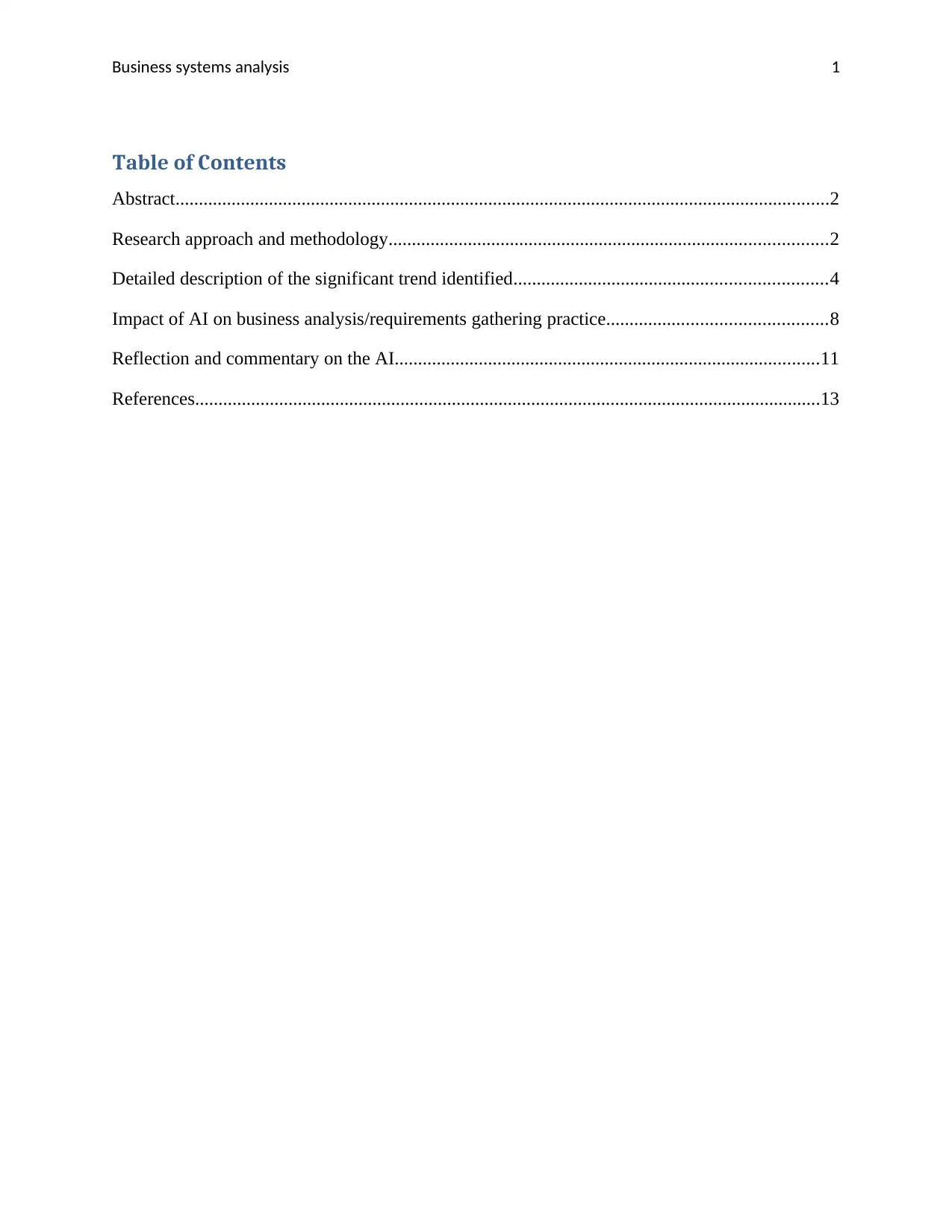
Business systems analysis 1
Table of Contents
Abstract............................................................................................................................................2
Research approach and methodology..............................................................................................2
Detailed description of the significant trend identified...................................................................4
Impact of AI on business analysis/requirements gathering practice...............................................8
Reflection and commentary on the AI...........................................................................................11
References......................................................................................................................................13
Table of Contents
Abstract............................................................................................................................................2
Research approach and methodology..............................................................................................2
Detailed description of the significant trend identified...................................................................4
Impact of AI on business analysis/requirements gathering practice...............................................8
Reflection and commentary on the AI...........................................................................................11
References......................................................................................................................................13
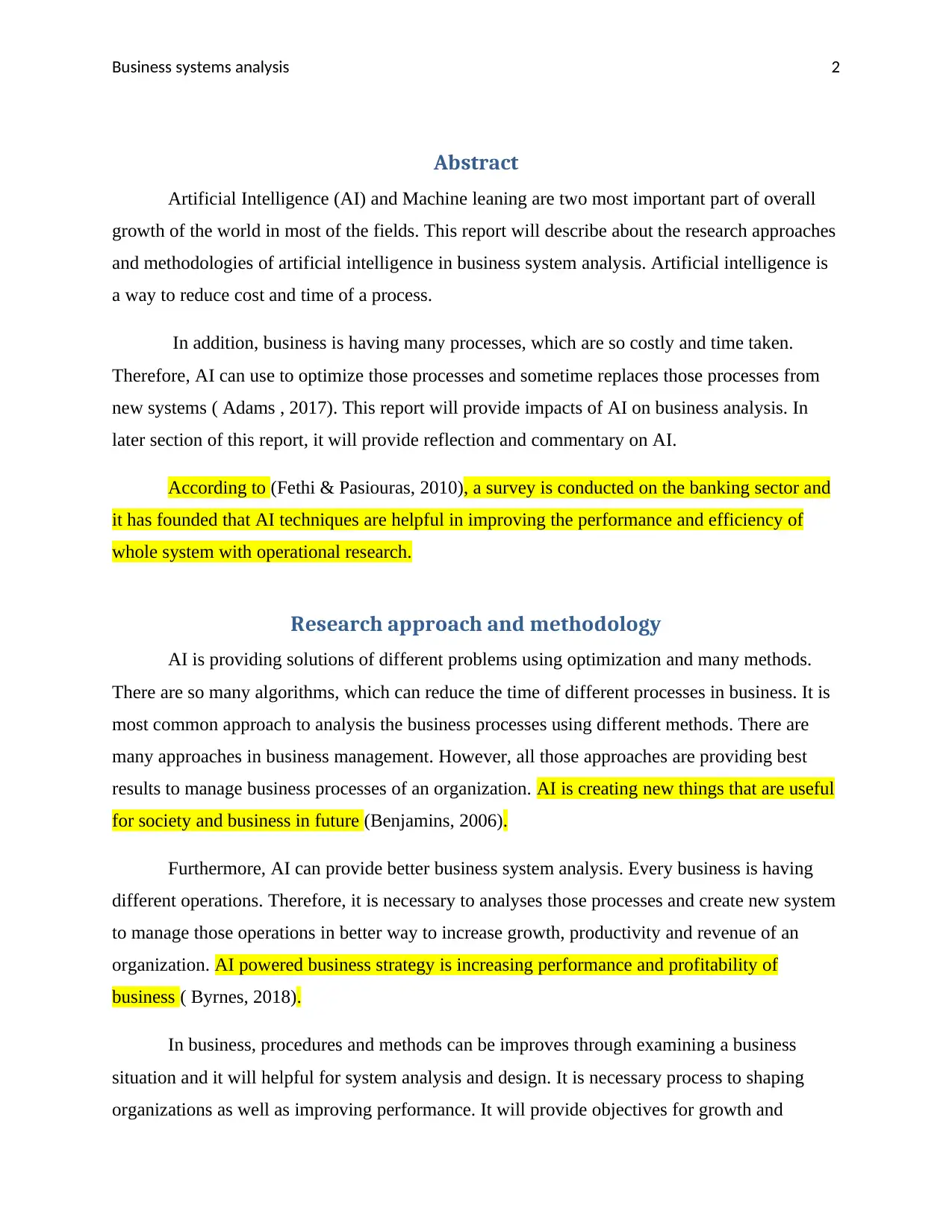
Business systems analysis 2
Abstract
Artificial Intelligence (AI) and Machine leaning are two most important part of overall
growth of the world in most of the fields. This report will describe about the research approaches
and methodologies of artificial intelligence in business system analysis. Artificial intelligence is
a way to reduce cost and time of a process.
In addition, business is having many processes, which are so costly and time taken.
Therefore, AI can use to optimize those processes and sometime replaces those processes from
new systems ( Adams , 2017). This report will provide impacts of AI on business analysis. In
later section of this report, it will provide reflection and commentary on AI.
According to (Fethi & Pasiouras, 2010), a survey is conducted on the banking sector and
it has founded that AI techniques are helpful in improving the performance and efficiency of
whole system with operational research.
Research approach and methodology
AI is providing solutions of different problems using optimization and many methods.
There are so many algorithms, which can reduce the time of different processes in business. It is
most common approach to analysis the business processes using different methods. There are
many approaches in business management. However, all those approaches are providing best
results to manage business processes of an organization. AI is creating new things that are useful
for society and business in future (Benjamins, 2006).
Furthermore, AI can provide better business system analysis. Every business is having
different operations. Therefore, it is necessary to analyses those processes and create new system
to manage those operations in better way to increase growth, productivity and revenue of an
organization. AI powered business strategy is increasing performance and profitability of
business ( Byrnes, 2018).
In business, procedures and methods can be improves through examining a business
situation and it will helpful for system analysis and design. It is necessary process to shaping
organizations as well as improving performance. It will provide objectives for growth and
Abstract
Artificial Intelligence (AI) and Machine leaning are two most important part of overall
growth of the world in most of the fields. This report will describe about the research approaches
and methodologies of artificial intelligence in business system analysis. Artificial intelligence is
a way to reduce cost and time of a process.
In addition, business is having many processes, which are so costly and time taken.
Therefore, AI can use to optimize those processes and sometime replaces those processes from
new systems ( Adams , 2017). This report will provide impacts of AI on business analysis. In
later section of this report, it will provide reflection and commentary on AI.
According to (Fethi & Pasiouras, 2010), a survey is conducted on the banking sector and
it has founded that AI techniques are helpful in improving the performance and efficiency of
whole system with operational research.
Research approach and methodology
AI is providing solutions of different problems using optimization and many methods.
There are so many algorithms, which can reduce the time of different processes in business. It is
most common approach to analysis the business processes using different methods. There are
many approaches in business management. However, all those approaches are providing best
results to manage business processes of an organization. AI is creating new things that are useful
for society and business in future (Benjamins, 2006).
Furthermore, AI can provide better business system analysis. Every business is having
different operations. Therefore, it is necessary to analyses those processes and create new system
to manage those operations in better way to increase growth, productivity and revenue of an
organization. AI powered business strategy is increasing performance and profitability of
business ( Byrnes, 2018).
In business, procedures and methods can be improves through examining a business
situation and it will helpful for system analysis and design. It is necessary process to shaping
organizations as well as improving performance. It will provide objectives for growth and
⊘ This is a preview!⊘
Do you want full access?
Subscribe today to unlock all pages.

Trusted by 1+ million students worldwide
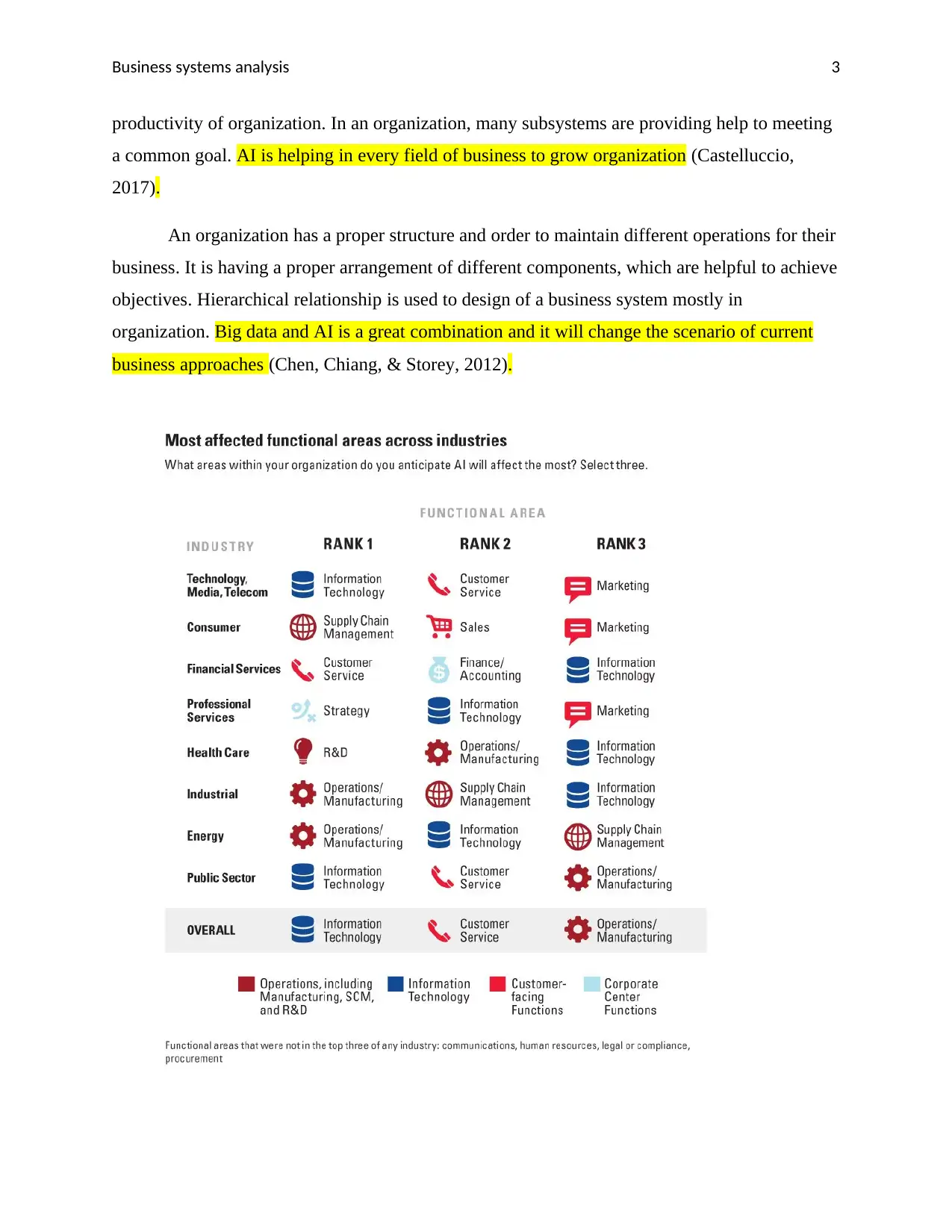
Business systems analysis 3
productivity of organization. In an organization, many subsystems are providing help to meeting
a common goal. AI is helping in every field of business to grow organization (Castelluccio,
2017).
An organization has a proper structure and order to maintain different operations for their
business. It is having a proper arrangement of different components, which are helpful to achieve
objectives. Hierarchical relationship is used to design of a business system mostly in
organization. Big data and AI is a great combination and it will change the scenario of current
business approaches (Chen, Chiang, & Storey, 2012).
productivity of organization. In an organization, many subsystems are providing help to meeting
a common goal. AI is helping in every field of business to grow organization (Castelluccio,
2017).
An organization has a proper structure and order to maintain different operations for their
business. It is having a proper arrangement of different components, which are helpful to achieve
objectives. Hierarchical relationship is used to design of a business system mostly in
organization. Big data and AI is a great combination and it will change the scenario of current
business approaches (Chen, Chiang, & Storey, 2012).
Paraphrase This Document
Need a fresh take? Get an instant paraphrase of this document with our AI Paraphraser
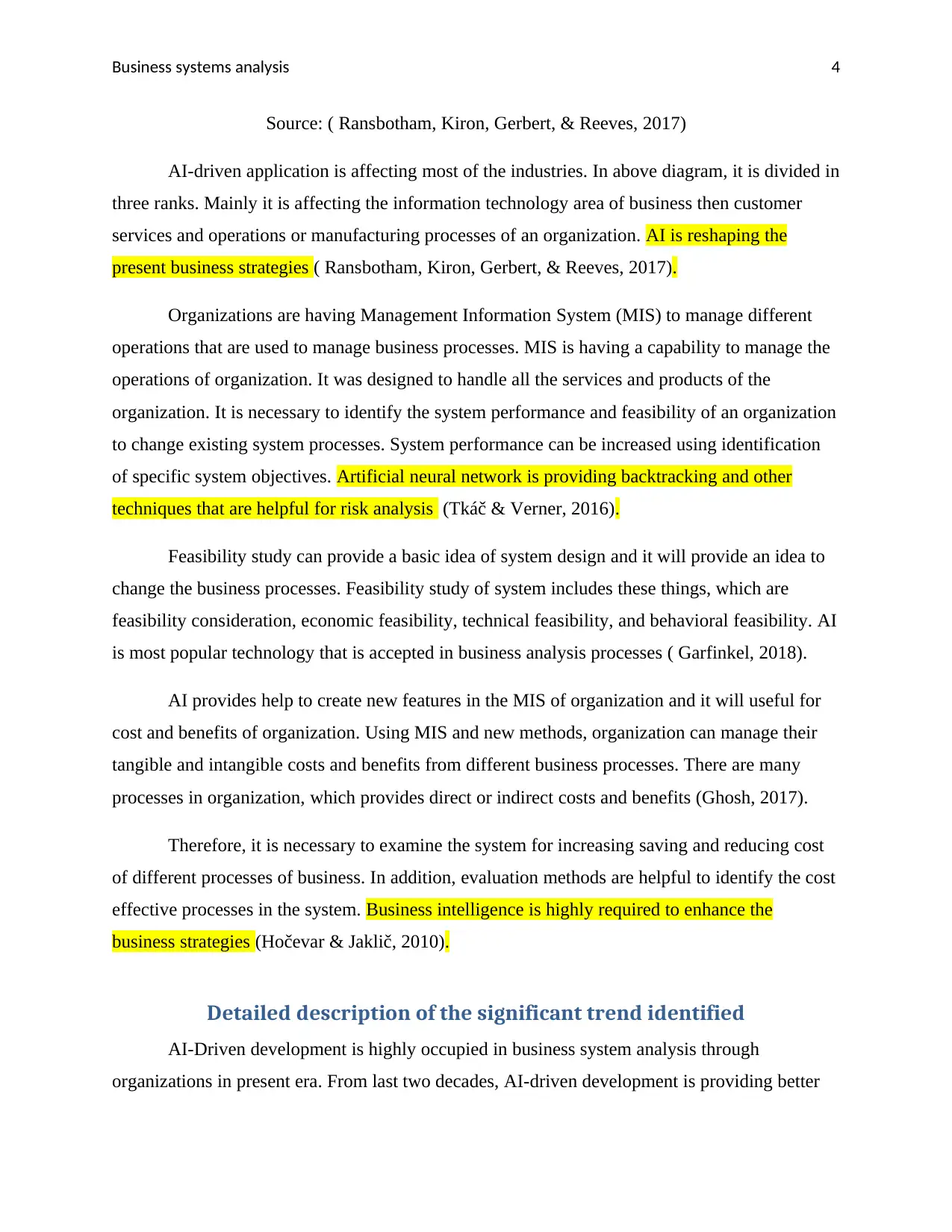
Business systems analysis 4
Source: ( Ransbotham, Kiron, Gerbert, & Reeves, 2017)
AI-driven application is affecting most of the industries. In above diagram, it is divided in
three ranks. Mainly it is affecting the information technology area of business then customer
services and operations or manufacturing processes of an organization. AI is reshaping the
present business strategies ( Ransbotham, Kiron, Gerbert, & Reeves, 2017).
Organizations are having Management Information System (MIS) to manage different
operations that are used to manage business processes. MIS is having a capability to manage the
operations of organization. It was designed to handle all the services and products of the
organization. It is necessary to identify the system performance and feasibility of an organization
to change existing system processes. System performance can be increased using identification
of specific system objectives. Artificial neural network is providing backtracking and other
techniques that are helpful for risk analysis (Tkáč & Verner, 2016).
Feasibility study can provide a basic idea of system design and it will provide an idea to
change the business processes. Feasibility study of system includes these things, which are
feasibility consideration, economic feasibility, technical feasibility, and behavioral feasibility. AI
is most popular technology that is accepted in business analysis processes ( Garfinkel, 2018).
AI provides help to create new features in the MIS of organization and it will useful for
cost and benefits of organization. Using MIS and new methods, organization can manage their
tangible and intangible costs and benefits from different business processes. There are many
processes in organization, which provides direct or indirect costs and benefits (Ghosh, 2017).
Therefore, it is necessary to examine the system for increasing saving and reducing cost
of different processes of business. In addition, evaluation methods are helpful to identify the cost
effective processes in the system. Business intelligence is highly required to enhance the
business strategies (Hočevar & Jaklič, 2010).
Detailed description of the significant trend identified
AI-Driven development is highly occupied in business system analysis through
organizations in present era. From last two decades, AI-driven development is providing better
Source: ( Ransbotham, Kiron, Gerbert, & Reeves, 2017)
AI-driven application is affecting most of the industries. In above diagram, it is divided in
three ranks. Mainly it is affecting the information technology area of business then customer
services and operations or manufacturing processes of an organization. AI is reshaping the
present business strategies ( Ransbotham, Kiron, Gerbert, & Reeves, 2017).
Organizations are having Management Information System (MIS) to manage different
operations that are used to manage business processes. MIS is having a capability to manage the
operations of organization. It was designed to handle all the services and products of the
organization. It is necessary to identify the system performance and feasibility of an organization
to change existing system processes. System performance can be increased using identification
of specific system objectives. Artificial neural network is providing backtracking and other
techniques that are helpful for risk analysis (Tkáč & Verner, 2016).
Feasibility study can provide a basic idea of system design and it will provide an idea to
change the business processes. Feasibility study of system includes these things, which are
feasibility consideration, economic feasibility, technical feasibility, and behavioral feasibility. AI
is most popular technology that is accepted in business analysis processes ( Garfinkel, 2018).
AI provides help to create new features in the MIS of organization and it will useful for
cost and benefits of organization. Using MIS and new methods, organization can manage their
tangible and intangible costs and benefits from different business processes. There are many
processes in organization, which provides direct or indirect costs and benefits (Ghosh, 2017).
Therefore, it is necessary to examine the system for increasing saving and reducing cost
of different processes of business. In addition, evaluation methods are helpful to identify the cost
effective processes in the system. Business intelligence is highly required to enhance the
business strategies (Hočevar & Jaklič, 2010).
Detailed description of the significant trend identified
AI-Driven development is highly occupied in business system analysis through
organizations in present era. From last two decades, AI-driven development is providing better
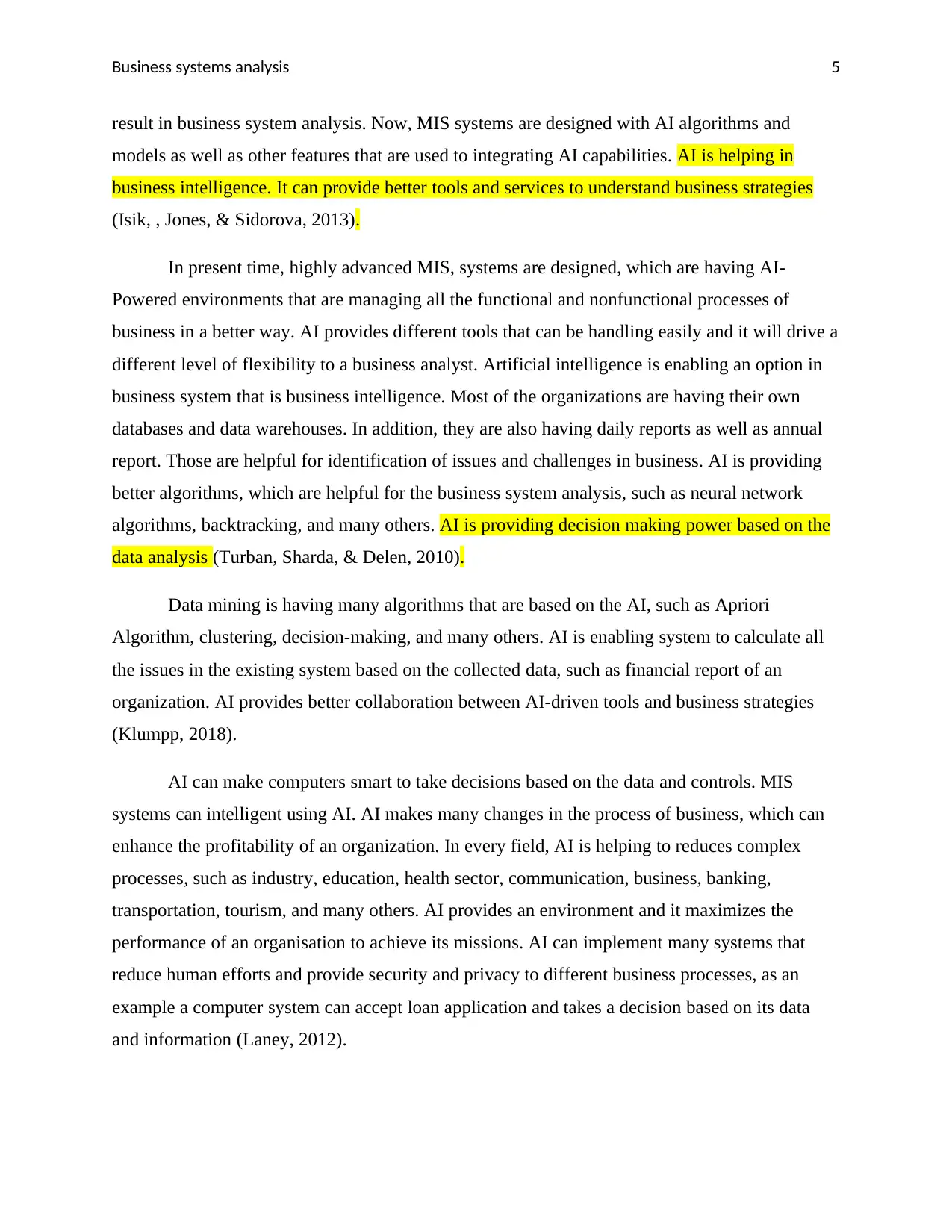
Business systems analysis 5
result in business system analysis. Now, MIS systems are designed with AI algorithms and
models as well as other features that are used to integrating AI capabilities. AI is helping in
business intelligence. It can provide better tools and services to understand business strategies
(Isik, , Jones, & Sidorova, 2013).
In present time, highly advanced MIS, systems are designed, which are having AI-
Powered environments that are managing all the functional and nonfunctional processes of
business in a better way. AI provides different tools that can be handling easily and it will drive a
different level of flexibility to a business analyst. Artificial intelligence is enabling an option in
business system that is business intelligence. Most of the organizations are having their own
databases and data warehouses. In addition, they are also having daily reports as well as annual
report. Those are helpful for identification of issues and challenges in business. AI is providing
better algorithms, which are helpful for the business system analysis, such as neural network
algorithms, backtracking, and many others. AI is providing decision making power based on the
data analysis (Turban, Sharda, & Delen, 2010).
Data mining is having many algorithms that are based on the AI, such as Apriori
Algorithm, clustering, decision-making, and many others. AI is enabling system to calculate all
the issues in the existing system based on the collected data, such as financial report of an
organization. AI provides better collaboration between AI-driven tools and business strategies
(Klumpp, 2018).
AI can make computers smart to take decisions based on the data and controls. MIS
systems can intelligent using AI. AI makes many changes in the process of business, which can
enhance the profitability of an organization. In every field, AI is helping to reduces complex
processes, such as industry, education, health sector, communication, business, banking,
transportation, tourism, and many others. AI provides an environment and it maximizes the
performance of an organisation to achieve its missions. AI can implement many systems that
reduce human efforts and provide security and privacy to different business processes, as an
example a computer system can accept loan application and takes a decision based on its data
and information (Laney, 2012).
result in business system analysis. Now, MIS systems are designed with AI algorithms and
models as well as other features that are used to integrating AI capabilities. AI is helping in
business intelligence. It can provide better tools and services to understand business strategies
(Isik, , Jones, & Sidorova, 2013).
In present time, highly advanced MIS, systems are designed, which are having AI-
Powered environments that are managing all the functional and nonfunctional processes of
business in a better way. AI provides different tools that can be handling easily and it will drive a
different level of flexibility to a business analyst. Artificial intelligence is enabling an option in
business system that is business intelligence. Most of the organizations are having their own
databases and data warehouses. In addition, they are also having daily reports as well as annual
report. Those are helpful for identification of issues and challenges in business. AI is providing
better algorithms, which are helpful for the business system analysis, such as neural network
algorithms, backtracking, and many others. AI is providing decision making power based on the
data analysis (Turban, Sharda, & Delen, 2010).
Data mining is having many algorithms that are based on the AI, such as Apriori
Algorithm, clustering, decision-making, and many others. AI is enabling system to calculate all
the issues in the existing system based on the collected data, such as financial report of an
organization. AI provides better collaboration between AI-driven tools and business strategies
(Klumpp, 2018).
AI can make computers smart to take decisions based on the data and controls. MIS
systems can intelligent using AI. AI makes many changes in the process of business, which can
enhance the profitability of an organization. In every field, AI is helping to reduces complex
processes, such as industry, education, health sector, communication, business, banking,
transportation, tourism, and many others. AI provides an environment and it maximizes the
performance of an organisation to achieve its missions. AI can implement many systems that
reduce human efforts and provide security and privacy to different business processes, as an
example a computer system can accept loan application and takes a decision based on its data
and information (Laney, 2012).
⊘ This is a preview!⊘
Do you want full access?
Subscribe today to unlock all pages.

Trusted by 1+ million students worldwide

Business systems analysis 6
AI-driven systems are having learning capability. Therefore, they can take decision based
on the data and it is beneficial for the machine and organization. It will be beneficial for the
organization that machine can take decision based on the intelligence. An organization can make
their business intelligent using AI and it will be Business Intelligence (BI). AI provides a base to
the organization and BI is a new way to manage different operations of an organization in an
efficient way. AI is having two areas, which are most popular in present time that are machine
learning and deep learning. Machine learning is so beneficial for those industries, which are
based on the data and machines. A computer system can maintain the entire machine using
mechanical concepts and computer knowledge. It can increase performance of a system using
machine learning. AI increases business intelligence, which is reduces losses of organization
(Zeng, Li, & Duan, 2012).
Source: ( Ransbotham, Kiron, Gerbert, & Reeves, 2017)
AI-driven systems are having learning capability. Therefore, they can take decision based
on the data and it is beneficial for the machine and organization. It will be beneficial for the
organization that machine can take decision based on the intelligence. An organization can make
their business intelligent using AI and it will be Business Intelligence (BI). AI provides a base to
the organization and BI is a new way to manage different operations of an organization in an
efficient way. AI is having two areas, which are most popular in present time that are machine
learning and deep learning. Machine learning is so beneficial for those industries, which are
based on the data and machines. A computer system can maintain the entire machine using
mechanical concepts and computer knowledge. It can increase performance of a system using
machine learning. AI increases business intelligence, which is reduces losses of organization
(Zeng, Li, & Duan, 2012).
Source: ( Ransbotham, Kiron, Gerbert, & Reeves, 2017)
Paraphrase This Document
Need a fresh take? Get an instant paraphrase of this document with our AI Paraphraser
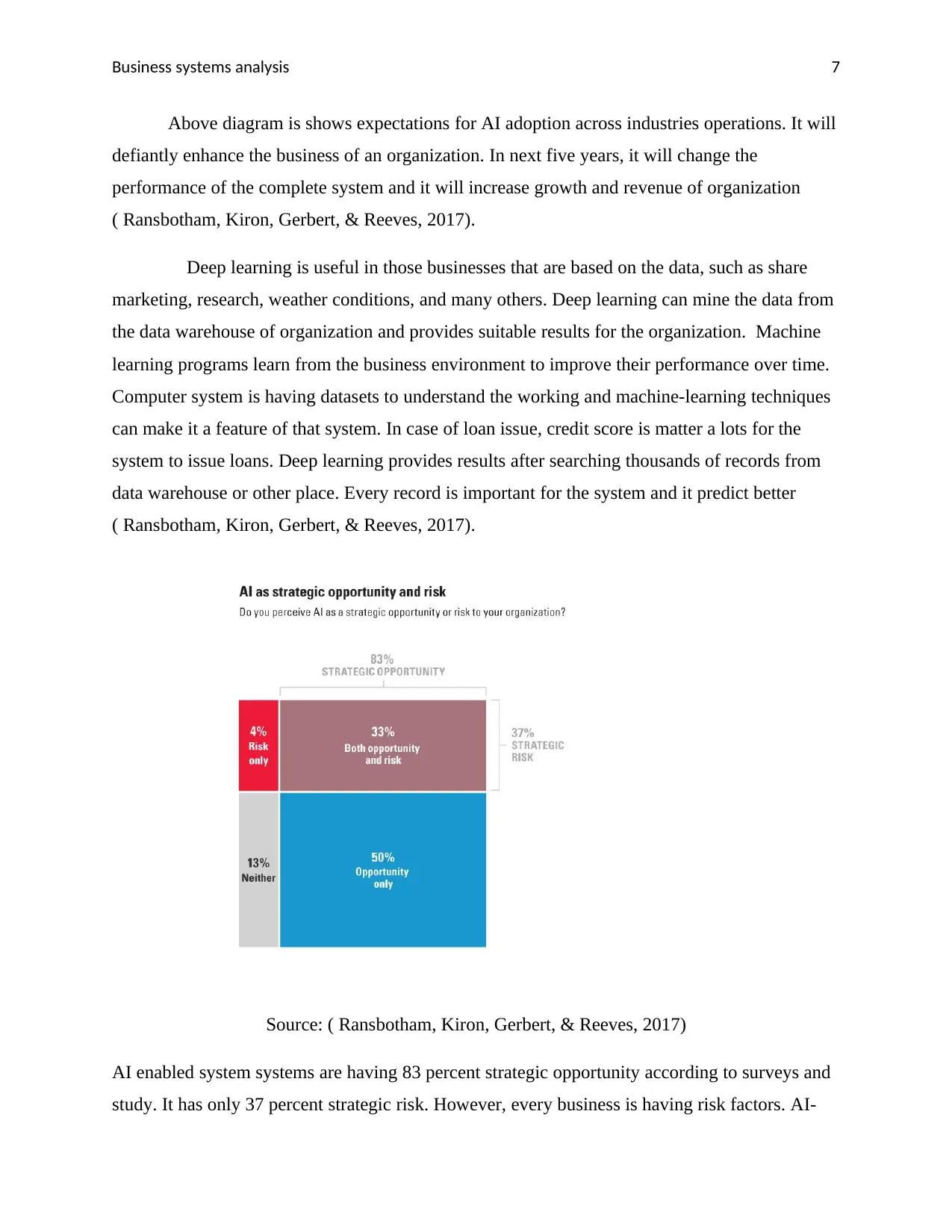
Business systems analysis 7
Above diagram is shows expectations for AI adoption across industries operations. It will
defiantly enhance the business of an organization. In next five years, it will change the
performance of the complete system and it will increase growth and revenue of organization
( Ransbotham, Kiron, Gerbert, & Reeves, 2017).
Deep learning is useful in those businesses that are based on the data, such as share
marketing, research, weather conditions, and many others. Deep learning can mine the data from
the data warehouse of organization and provides suitable results for the organization. Machine
learning programs learn from the business environment to improve their performance over time.
Computer system is having datasets to understand the working and machine-learning techniques
can make it a feature of that system. In case of loan issue, credit score is matter a lots for the
system to issue loans. Deep learning provides results after searching thousands of records from
data warehouse or other place. Every record is important for the system and it predict better
( Ransbotham, Kiron, Gerbert, & Reeves, 2017).
Source: ( Ransbotham, Kiron, Gerbert, & Reeves, 2017)
AI enabled system systems are having 83 percent strategic opportunity according to surveys and
study. It has only 37 percent strategic risk. However, every business is having risk factors. AI-
Above diagram is shows expectations for AI adoption across industries operations. It will
defiantly enhance the business of an organization. In next five years, it will change the
performance of the complete system and it will increase growth and revenue of organization
( Ransbotham, Kiron, Gerbert, & Reeves, 2017).
Deep learning is useful in those businesses that are based on the data, such as share
marketing, research, weather conditions, and many others. Deep learning can mine the data from
the data warehouse of organization and provides suitable results for the organization. Machine
learning programs learn from the business environment to improve their performance over time.
Computer system is having datasets to understand the working and machine-learning techniques
can make it a feature of that system. In case of loan issue, credit score is matter a lots for the
system to issue loans. Deep learning provides results after searching thousands of records from
data warehouse or other place. Every record is important for the system and it predict better
( Ransbotham, Kiron, Gerbert, & Reeves, 2017).
Source: ( Ransbotham, Kiron, Gerbert, & Reeves, 2017)
AI enabled system systems are having 83 percent strategic opportunity according to surveys and
study. It has only 37 percent strategic risk. However, every business is having risk factors. AI-
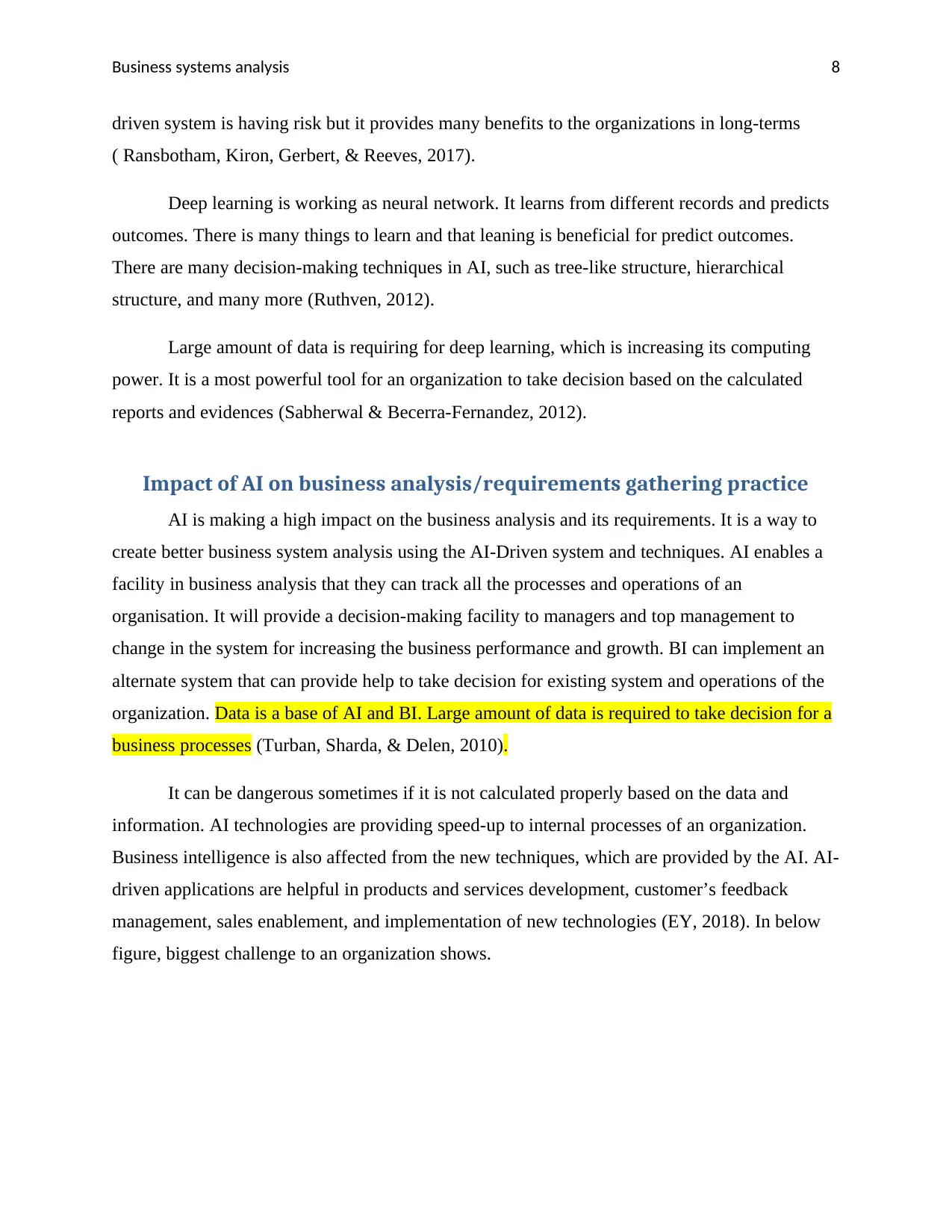
Business systems analysis 8
driven system is having risk but it provides many benefits to the organizations in long-terms
( Ransbotham, Kiron, Gerbert, & Reeves, 2017).
Deep learning is working as neural network. It learns from different records and predicts
outcomes. There is many things to learn and that leaning is beneficial for predict outcomes.
There are many decision-making techniques in AI, such as tree-like structure, hierarchical
structure, and many more (Ruthven, 2012).
Large amount of data is requiring for deep learning, which is increasing its computing
power. It is a most powerful tool for an organization to take decision based on the calculated
reports and evidences (Sabherwal & Becerra-Fernandez, 2012).
Impact of AI on business analysis/requirements gathering practice
AI is making a high impact on the business analysis and its requirements. It is a way to
create better business system analysis using the AI-Driven system and techniques. AI enables a
facility in business analysis that they can track all the processes and operations of an
organisation. It will provide a decision-making facility to managers and top management to
change in the system for increasing the business performance and growth. BI can implement an
alternate system that can provide help to take decision for existing system and operations of the
organization. Data is a base of AI and BI. Large amount of data is required to take decision for a
business processes (Turban, Sharda, & Delen, 2010).
It can be dangerous sometimes if it is not calculated properly based on the data and
information. AI technologies are providing speed-up to internal processes of an organization.
Business intelligence is also affected from the new techniques, which are provided by the AI. AI-
driven applications are helpful in products and services development, customer’s feedback
management, sales enablement, and implementation of new technologies (EY, 2018). In below
figure, biggest challenge to an organization shows.
driven system is having risk but it provides many benefits to the organizations in long-terms
( Ransbotham, Kiron, Gerbert, & Reeves, 2017).
Deep learning is working as neural network. It learns from different records and predicts
outcomes. There is many things to learn and that leaning is beneficial for predict outcomes.
There are many decision-making techniques in AI, such as tree-like structure, hierarchical
structure, and many more (Ruthven, 2012).
Large amount of data is requiring for deep learning, which is increasing its computing
power. It is a most powerful tool for an organization to take decision based on the calculated
reports and evidences (Sabherwal & Becerra-Fernandez, 2012).
Impact of AI on business analysis/requirements gathering practice
AI is making a high impact on the business analysis and its requirements. It is a way to
create better business system analysis using the AI-Driven system and techniques. AI enables a
facility in business analysis that they can track all the processes and operations of an
organisation. It will provide a decision-making facility to managers and top management to
change in the system for increasing the business performance and growth. BI can implement an
alternate system that can provide help to take decision for existing system and operations of the
organization. Data is a base of AI and BI. Large amount of data is required to take decision for a
business processes (Turban, Sharda, & Delen, 2010).
It can be dangerous sometimes if it is not calculated properly based on the data and
information. AI technologies are providing speed-up to internal processes of an organization.
Business intelligence is also affected from the new techniques, which are provided by the AI. AI-
driven applications are helpful in products and services development, customer’s feedback
management, sales enablement, and implementation of new technologies (EY, 2018). In below
figure, biggest challenge to an organization shows.
⊘ This is a preview!⊘
Do you want full access?
Subscribe today to unlock all pages.

Trusted by 1+ million students worldwide
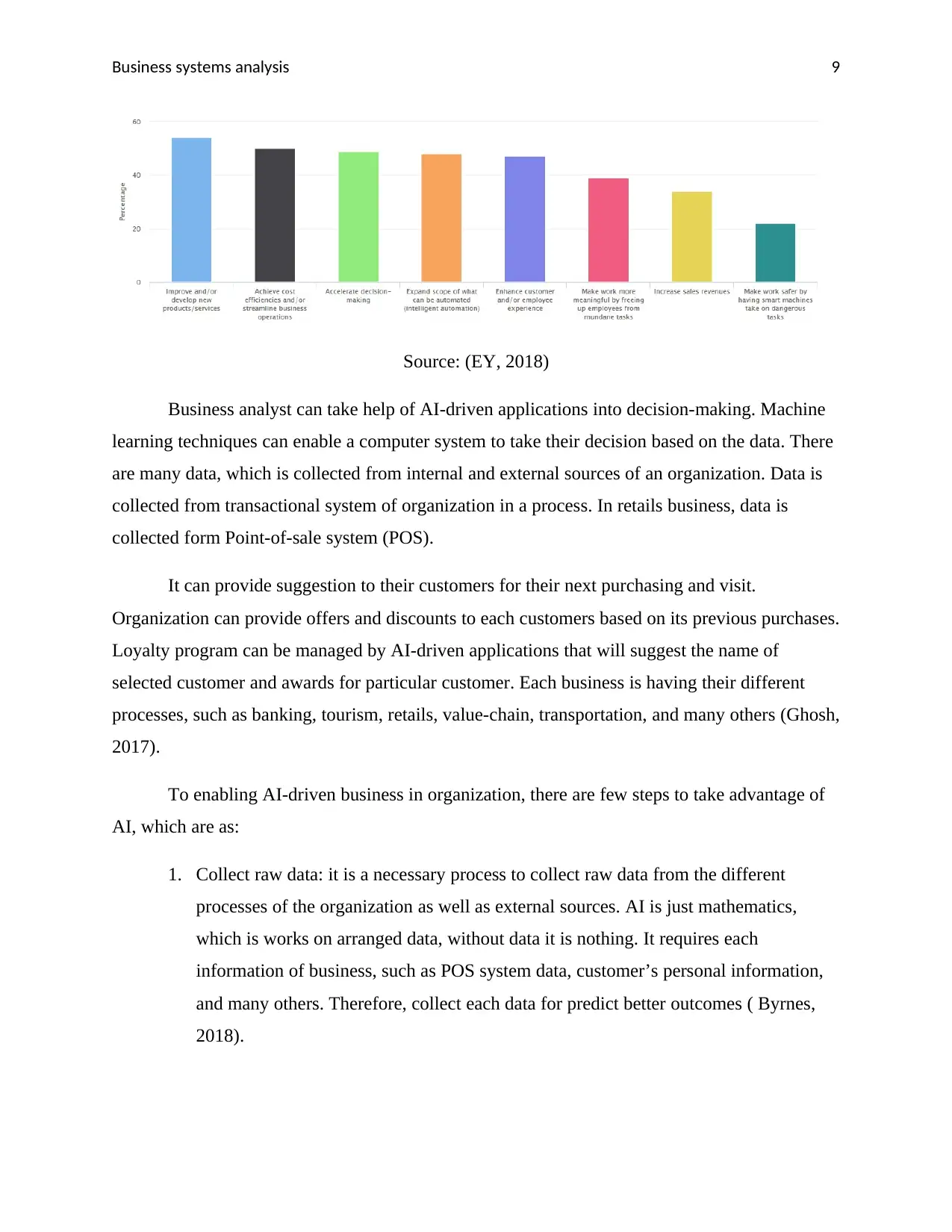
Business systems analysis 9
Source: (EY, 2018)
Business analyst can take help of AI-driven applications into decision-making. Machine
learning techniques can enable a computer system to take their decision based on the data. There
are many data, which is collected from internal and external sources of an organization. Data is
collected from transactional system of organization in a process. In retails business, data is
collected form Point-of-sale system (POS).
It can provide suggestion to their customers for their next purchasing and visit.
Organization can provide offers and discounts to each customers based on its previous purchases.
Loyalty program can be managed by AI-driven applications that will suggest the name of
selected customer and awards for particular customer. Each business is having their different
processes, such as banking, tourism, retails, value-chain, transportation, and many others (Ghosh,
2017).
To enabling AI-driven business in organization, there are few steps to take advantage of
AI, which are as:
1. Collect raw data: it is a necessary process to collect raw data from the different
processes of the organization as well as external sources. AI is just mathematics,
which is works on arranged data, without data it is nothing. It requires each
information of business, such as POS system data, customer’s personal information,
and many others. Therefore, collect each data for predict better outcomes ( Byrnes,
2018).
Source: (EY, 2018)
Business analyst can take help of AI-driven applications into decision-making. Machine
learning techniques can enable a computer system to take their decision based on the data. There
are many data, which is collected from internal and external sources of an organization. Data is
collected from transactional system of organization in a process. In retails business, data is
collected form Point-of-sale system (POS).
It can provide suggestion to their customers for their next purchasing and visit.
Organization can provide offers and discounts to each customers based on its previous purchases.
Loyalty program can be managed by AI-driven applications that will suggest the name of
selected customer and awards for particular customer. Each business is having their different
processes, such as banking, tourism, retails, value-chain, transportation, and many others (Ghosh,
2017).
To enabling AI-driven business in organization, there are few steps to take advantage of
AI, which are as:
1. Collect raw data: it is a necessary process to collect raw data from the different
processes of the organization as well as external sources. AI is just mathematics,
which is works on arranged data, without data it is nothing. It requires each
information of business, such as POS system data, customer’s personal information,
and many others. Therefore, collect each data for predict better outcomes ( Byrnes,
2018).
Paraphrase This Document
Need a fresh take? Get an instant paraphrase of this document with our AI Paraphraser
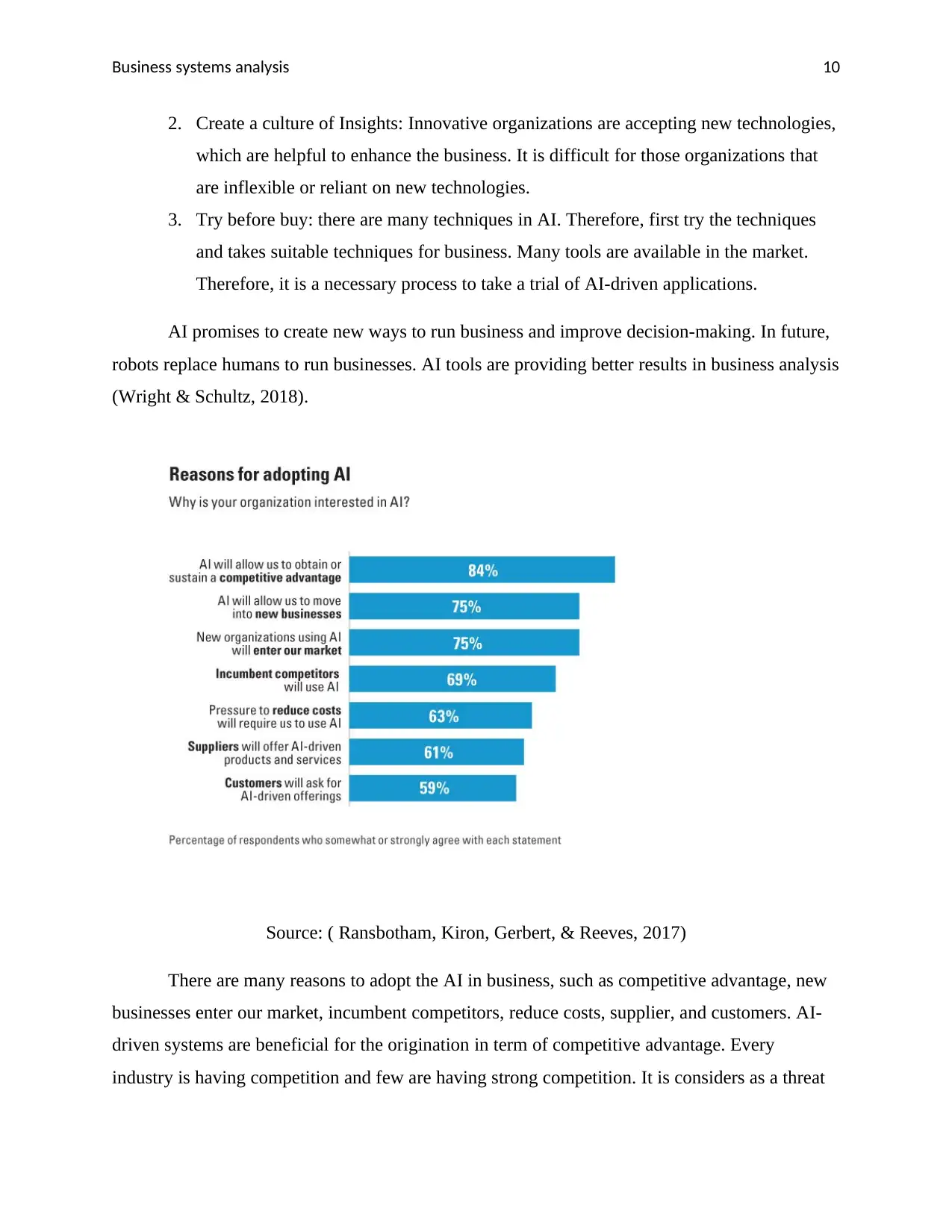
Business systems analysis 10
2. Create a culture of Insights: Innovative organizations are accepting new technologies,
which are helpful to enhance the business. It is difficult for those organizations that
are inflexible or reliant on new technologies.
3. Try before buy: there are many techniques in AI. Therefore, first try the techniques
and takes suitable techniques for business. Many tools are available in the market.
Therefore, it is a necessary process to take a trial of AI-driven applications.
AI promises to create new ways to run business and improve decision-making. In future,
robots replace humans to run businesses. AI tools are providing better results in business analysis
(Wright & Schultz, 2018).
Source: ( Ransbotham, Kiron, Gerbert, & Reeves, 2017)
There are many reasons to adopt the AI in business, such as competitive advantage, new
businesses enter our market, incumbent competitors, reduce costs, supplier, and customers. AI-
driven systems are beneficial for the origination in term of competitive advantage. Every
industry is having competition and few are having strong competition. It is considers as a threat
2. Create a culture of Insights: Innovative organizations are accepting new technologies,
which are helpful to enhance the business. It is difficult for those organizations that
are inflexible or reliant on new technologies.
3. Try before buy: there are many techniques in AI. Therefore, first try the techniques
and takes suitable techniques for business. Many tools are available in the market.
Therefore, it is a necessary process to take a trial of AI-driven applications.
AI promises to create new ways to run business and improve decision-making. In future,
robots replace humans to run businesses. AI tools are providing better results in business analysis
(Wright & Schultz, 2018).
Source: ( Ransbotham, Kiron, Gerbert, & Reeves, 2017)
There are many reasons to adopt the AI in business, such as competitive advantage, new
businesses enter our market, incumbent competitors, reduce costs, supplier, and customers. AI-
driven systems are beneficial for the origination in term of competitive advantage. Every
industry is having competition and few are having strong competition. It is considers as a threat

Business systems analysis 11
or external force according to porter’s five force model. Therefore, it is necessary to involved
AI-driven application in processing of different operations.
Reflection and commentary on the AI
I leant from the study that AI-driven business strategies are requires to enhancing the
business of an organization. It provides many benefits to the organization, which is based on the
data and information. That information can be collected from raw data of business processes.
Machine learning and deep learning are highly used techniques that are providing better results
in business analysis. According to (Castelluccio, 2017), AI improves performance of the internal
processes of the system, which is affecting overall growth of an organization. We can take AI as
an additional benefit to our business processes. It enables different capacities of business
processes. AI-driven applications are best for real-time decision-making. Many times, it is
necessary to take decision in less time. Therefore, AI-driven system can predict better outcomes
based on the data.
Without data, AI is nothing and it cannot help in business analysis. AI-driven systems can
analysis a huge system in few seconds. It can provide data as can possible. IBM’s Watson is a
great example of the AI-driven development. It is an example of an intelligent machine, which
take decision as a human being based on the data and proper management of processes (IBM,
2019).
I learn that AI-driven system is best way to enhancing profitability of an organization. It
can take business analysis of an existing systems and it suggests about the changes in the existing
system and business processes. I learnt from the whole study that AI adoption is little bit risky
but it is a normal thing that business has risk. Therefore, most of the organization should adopt
the AI-driven system to manage their business processes, such as business analysis, and many
others. Business system analysis is a process, which required proper information to take
decisions for current and new business processes. AI tools and techniques are most suitable
things to analyses business risks. Information technology is providing support to manage many
operations of an organization and AI is enhancing the information technology features. AI can
provide better results as compared to existing system to manage the customer services and
or external force according to porter’s five force model. Therefore, it is necessary to involved
AI-driven application in processing of different operations.
Reflection and commentary on the AI
I leant from the study that AI-driven business strategies are requires to enhancing the
business of an organization. It provides many benefits to the organization, which is based on the
data and information. That information can be collected from raw data of business processes.
Machine learning and deep learning are highly used techniques that are providing better results
in business analysis. According to (Castelluccio, 2017), AI improves performance of the internal
processes of the system, which is affecting overall growth of an organization. We can take AI as
an additional benefit to our business processes. It enables different capacities of business
processes. AI-driven applications are best for real-time decision-making. Many times, it is
necessary to take decision in less time. Therefore, AI-driven system can predict better outcomes
based on the data.
Without data, AI is nothing and it cannot help in business analysis. AI-driven systems can
analysis a huge system in few seconds. It can provide data as can possible. IBM’s Watson is a
great example of the AI-driven development. It is an example of an intelligent machine, which
take decision as a human being based on the data and proper management of processes (IBM,
2019).
I learn that AI-driven system is best way to enhancing profitability of an organization. It
can take business analysis of an existing systems and it suggests about the changes in the existing
system and business processes. I learnt from the whole study that AI adoption is little bit risky
but it is a normal thing that business has risk. Therefore, most of the organization should adopt
the AI-driven system to manage their business processes, such as business analysis, and many
others. Business system analysis is a process, which required proper information to take
decisions for current and new business processes. AI tools and techniques are most suitable
things to analyses business risks. Information technology is providing support to manage many
operations of an organization and AI is enhancing the information technology features. AI can
provide better results as compared to existing system to manage the customer services and
⊘ This is a preview!⊘
Do you want full access?
Subscribe today to unlock all pages.

Trusted by 1+ million students worldwide
1 out of 16
Related Documents
Your All-in-One AI-Powered Toolkit for Academic Success.
+13062052269
info@desklib.com
Available 24*7 on WhatsApp / Email
![[object Object]](/_next/static/media/star-bottom.7253800d.svg)
Unlock your academic potential
Copyright © 2020–2025 A2Z Services. All Rights Reserved. Developed and managed by ZUCOL.



